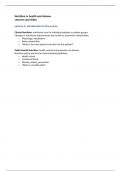Nutri&on in health and disease
Lectures and slides
Lecture 1: Introduc&on to the course
Clinical Nutri,on: nutri'onal care for individual pa'ents or pa'ent groups
Changes in nutri'onal requirements due to illness, treatment, malnutri'on
o Physiology, metabolism
o Body composi'on
o ‘What is the most op'mal nutri'on for this pa'ent?’
Public Health Nutri,on: health control and preven'on of disease
Nutri'on policy and local or (inter)na'onal guidelines.
o Health claims
o Func'onal foods
o Obesity, elderly, preven'on
o ‘What is a healthy diet?’
,Lecture 2: rules and regula&ons in clinical nutri&on research
Background of a research ques'on
A research ques'on always must be PICO (pa'ent, interven'on, control, and outcome)
To process a study, you need a certain budget for:
• The salary of the researcher, research assistant, health care worker, data manager,
sta's'cian
• Equipment (depending on measurements)
• Laboratory costs
• Educa'on (courses, conferences etc.)
• Office equipment (computer, paper, pencils etc.)
• Travel costs of par'cipants
You can apply for a grant (financiering) at for example: health insurance companies and the
medical industry.
To do before you can do research:
o Write protocol.
o Present protocol to department(s) involved.
o Prepare protocol and other files for Scien'fic Research CommiUee
o Prepare protocol and other files for Medical Research Ethical CommiUee (MREC /
Dutch: METC)
o Prepare logis'cs.
Work out a research ques'on. Select your study popula'on: think about inclusion and
exclusion criteria and the size of the popula'on. Select your study design, for example:
randomized controlled trial.
To prevent bias, you can blind people in the study. In a single-blind study, pa'ents do not
know which study group they are in (for example whether they are taking the experimental
drug or a placebo). In a double-blind study, neither the pa'ents nor the researchers/doctors
know which study group the pa'ents are in. In a triple-blind study, the pa'ents, clinicians,
and the people carrying out the sta's'cal analysis do not know which treatment pa'ents
had.
,If you have an individualized nutri'onal counseling session the pa'ents know if they are in
the control group, so you cannot blind the pa'ent and cannot blind the die'cian because
they must know what it is about. You can blind the person who does the analysis, so it is a
single blind study. Blinding is important for preven'ng bias.
Primary outcome: when you look at the most important outcome it must be something you
can measure.
Sample size calcula'on
n = number of par'cipants in interven'on or control group
α = 0.05 (significance)
β = 80% (power)
σ = variance (from literature)
ν = difference in outcome (clinically relevant)
You need a sample size calcula'on because:
o If your sample is too small (n = too small) à false, nega've conclusion
o If your sample is too large (n = too large) à interven'on effec've: too many subjects
have missed out on this interven'on. Interven'on ineffec've: too many have been
exposed to this ineffec've interven'on.
So, you don’t want your sample size to be too small and you don’t want it to be too large, so
you must do a sample size calcula'on.
What informa,on do you need?
Desired power of the study (1 – ß)
How certain do you want to be of preven'ng a type II error?
80% - accep,ng a chance of 20% of failing to detect an effect that is indeed present in the
popula,on (false nega,ve)
Desired significance level (α)
How certain do you want to be of preven'ng a type I error?
5% - accep,ng a chance of 0.05 to detect an effect in your study that is not present in the
whole popula,on (false posi,ve)
Desired test direc,on
One or two sided?
2-sided: treatment A beFer than treatment B // treatment B beFer than treatment A
, Clinically relevant (or expected) difference (v)
Which difference or which effect are you trying to find?
From literature
Expected variance / standard devia,on (σ)
How much varia'on is expected in subjects belonging to the same study group?
From pilot data or literature
Type I error (α) - the probability of falsely rejec,ng H0.
Type II error (β) - the probability of falsely accep,ng H0.
AQri,on rate
Always take in to account the aUri'on rate. An'cipate on the number of included subjects
who will not be available for the study analysis.! If you are researching a sick popula'on, you
will probably have a big drop out group.
Expected drop-out/withdrawal from previous studies, e.g. if 10% drop-out is expected: divide
number needed by 0.9.
Differences in means, e.g.
For example, the difference in body weight change between groups, or the difference in
survival 'me between groups
Differences in propor,ons, e.g.
For example: difference in propor'ons (%) with a certain weight loss between groups, or
difference in propor'ons (%) 1 year survival between groups.
It is not always ethical to have a control group. If there is literature that the interven'on is
beneficial, it is not ethical to leave the control group without the interven'on.
You always must arrange an insurance, that is usually arranged by the hospital.




